Last Updated on April 4, 2024
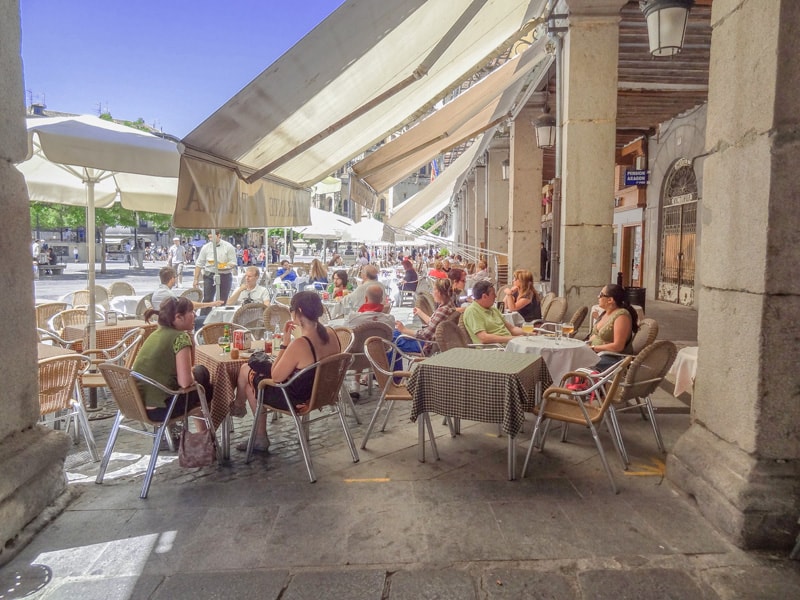
Estimated reading time: 7 minutes
Updated for 2022
By Jim Ferri
A great and easy trip in Spain is a day trip from Madrid to Segovia.
When non-Spanish travelers take a day trip from Madrid, however, many often opt to go instead to Toledo. It’s the former home of the artist El Greco, and only about a half-hour train ride south of the city.
But for many, Segovia may be a better choice for a day trip from Madrid. It’s also only a half hour by train but north of Madrid. And it’s a beautiful city that’s a lot more relaxed place than Toledo. That’s because it doesn’t get the hordes of tourists that Toledo does.
It’s also a favorite place for Madrialeños to go for lunch on the weekends. You may want to do the same.
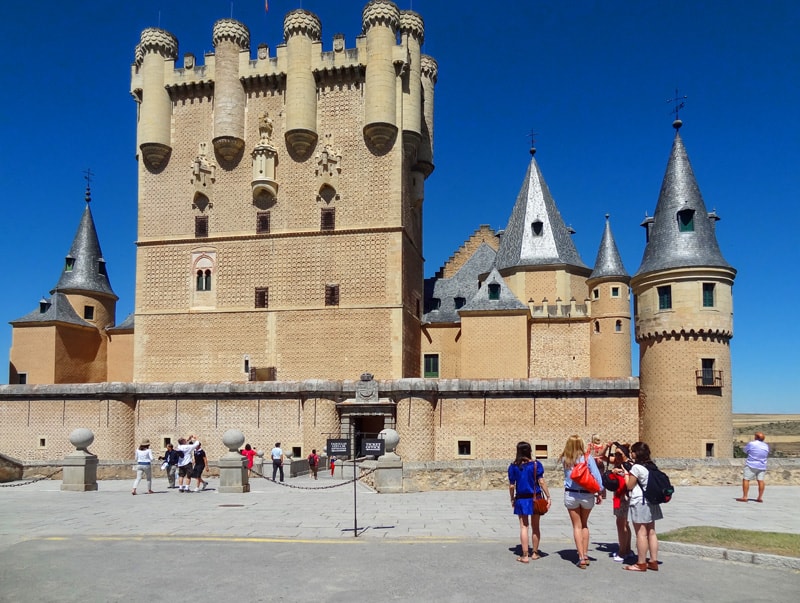
From Madrid to Segovia, An Easy Day Trip
The fairy-tale Castilian city of Segovia is one of the most spectacular cities in all of Spain.
Inside its old crenelated 11th-century city walls (partly built with gravestones snatched from a Roman necropolis) you’ll find one of the greatest surviving examples of ancient Roman engineering in the world.

You’ll also discover a bevy of Romanesque churches from medieval times. And there’s a beautiful castle, and narrow pedestrian streets wending their way through a lovely old city. To top it off, the entire old town is a UNESCO World Heritage Site.
And about that castle…the fairytale-looking Alcazar which dominates the skyline. It’s a beautiful castle, thought by many to be the model for Walt Disney’s Sleeping Beauty’s Castle.
But with its Rapunzel-like turrets and towers, you have to admit it does look a bit more German than Spanish. Some, however, believe it’s really Bavaria’s Neuschwanstein Castle that caught Walt’s eye.
Nevertheless, what you see now in Segovia is not the original. Today’s Alcazar was rebuilt in the 13th and 14th centuries, and then burned down in 1862. It was later partially reconstructed.
Admission to the Alcazar is €6 per person. Inside you’ll find two interesting salons, the Sala de las Piñas and the Sala de Reyes, and hidden passageways. You can also see the throne room, bedroom and Chapel of Ferdinand and Isabella, who later became Queen of Spain.
Go out on the ramparts for a good view of Segovia and the surrounding area. For an additional €3 you can climb the 152 steps of the spiral staircase in tower for an even better view.
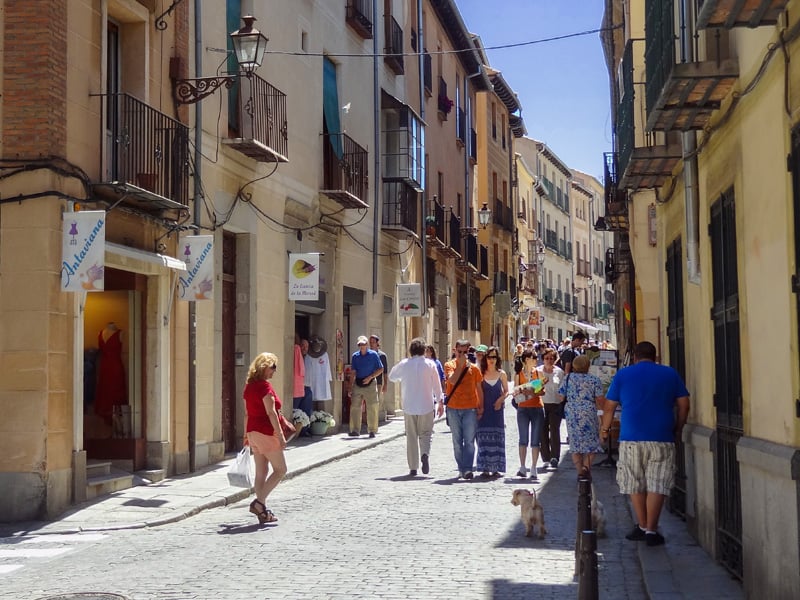
Segovia’s Old City
Leave the Alcazar and walk downhill along Calle de Daoiz, a pedestrian lane lined with little shops, galleries, and restaurants. It’s a great little Segovian street much less crowded than any you’ll find in Toledo. Or in many other more popular Spanish cities, as well.
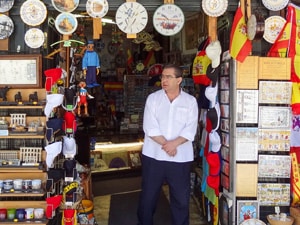
As we walked along we wandered in and out of several shops and galleries. We took our time as we ambled along, just wandering into into various shops to enjoy the ambiance.
Along the way we came to the home, now a museum, of Antonio Machado, one of Spain’s pre-eminent poets. He lived here from 1919 to 1932.
You’ll find a statue of Machado, a book tucked under his arm, down the street in the Plaza Mayor. It’s right across from the city’s famous and many-spired Gothic cathedral, the last built in Spain. Backing up to the old Jewish Quarter, it stands on the spot where Isabel I became Queen of Castile.
Construction of it begun in 1525, and it took more than 200 years to complete. Its austere interior, encompassing some 20 chapels, is a bit brightened by 16th-century Flemish windows. The attached Museo Categralicio, as one might expect, houses a collection of religious art.
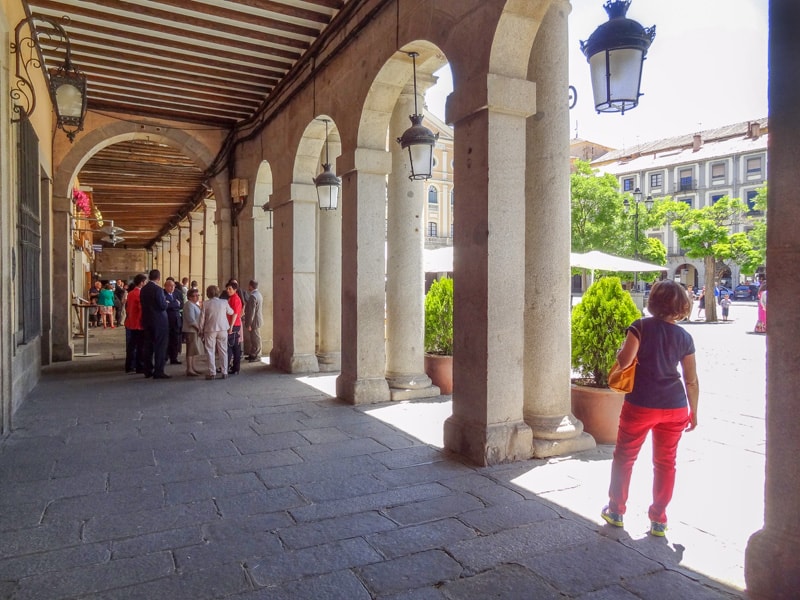
Plaza Mayor, the Center of Segovia
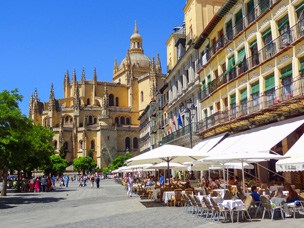
To me though, the real charm of the area was on the Plaza Mayor in front of the cathedral. The historic plaza has many restaurants and bars. They’re popular with those Madrialeños who travel to Segovia from Madrid on the weekends. It’s also one of the most comfortable little squares I’ve seen in any small city or town.
The colonnade on its north side is flush with restaurants and outdoor cafés. Under a under a canopy of umbrellas and awnings, we wandered past people either finishing a late breakfast or gathering before lunch.
I watched one large family group, all well dressed, that had likely just come from a christening in the cathedral. As the women gathered around the tables beneath the umbrellas, the men stood off to the side sipping their beers and coffees.
You can do some serious lunching in Segovia where the meal often starts about 3 PM. If you haven’t made reservations at one of the better restaurants just show up a bit earlier, perhaps at 1-1:30 PM, and you likely won’t have a problem.
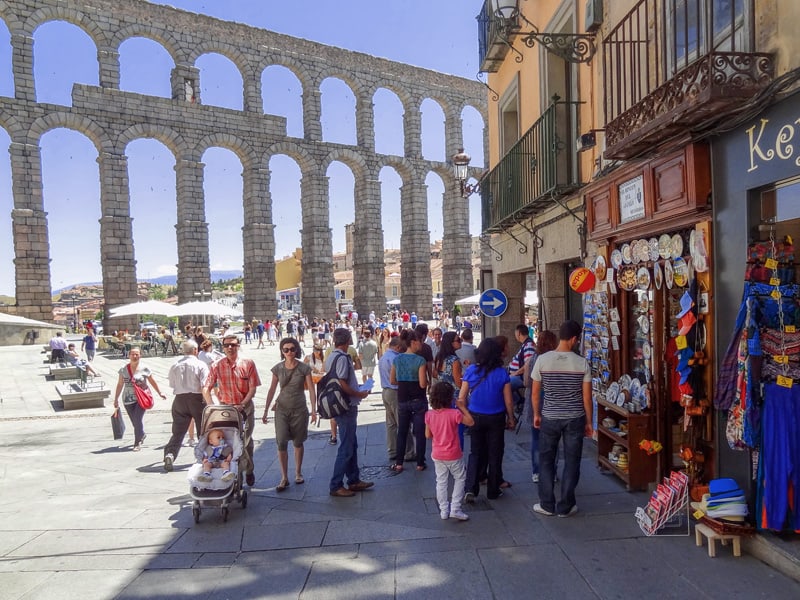
Mesón De Cándido and El Acueducto
Segovia’s Plaza Mayor was the kind of place where we could have easily whiled away the afternoon watching the passing parade. But after a while we had to move on to meet some friends at the Mesón De Cándido, a famous restaurant on the Plaza Azoguejo.

Plaza Azoguejo is where you can best see El Acueducto, the nearly 3,000-foot long Roman Aqueduct built in the 1st century AD to carry water from the mountains to the town. For being almost 2,000 years old, it’s in remarkably good shape.
Along with the Pont du Gard in Southern France, it’s one of the last remaining marvels of Roman engineering in the world. Amazingly, no mortar was used to hold together its 24,000 rough-hewn granite blocks.
Mesón De Cándido is a rustic restaurant in a 19th-century half-timbered house on the plaza, right at the base of El Acueducto. It’s well known for its suckling pig – a famous regional dish – that’s been enjoyed by numerous celebs including Hemingway and Nixon. With its old plaster walls, beamed ceilings, and narrow, worn stone stairway, it also serves up a good helping of ambiance.
Our waiter had told us that the suckling pig is cut with a plate. Still, though, I was surprised later when the pig was brought out and “plated” by Cándido’s owner, who then smashed the plate on the stone floor to the applause of everyone in the room.
In some respects, it was almost as amazing as that Roman marvel outside the door.
You may also enjoy: 48 Hours in Barcelona / 5 Unique Madrid Experiences / Best Things to Do in Seville, Spain’s Seductive City

Thsnk you for this introduction to Segovia. Segovia had not been on our list so far. We have not visited Spain altough we have considered it . The idea of Madrid for a home base with side trips begins to tempt me.
Segovia, especially the Aqueduct, is on my bucket list! Loved your photo of the aqueduct. Someday…
Segovia is a great laid-back city. Be sure to have a meal there!
Jim
Thanks for the valuable info ‘re Segovia…we are going to visit Madrid at the end of January and we intend to spend a day in Segovia. Can you please give us some info which is the best way to go? An organised tour? By bus? By train? If the latter, from which bus or train station?
Thank you
Hi Carmen,
You should have a wonderful time in Madrid – it’s a great world city. Have you read some of our articles on Madrid and other areas of Spain? I can’t tell you offhand where buses or train leave from in Madrid. But if you go to the website https://www.rome2rio.com that will tell you the costs of all different kinds of transportation (including bus and train) with the price as well as the station from which they leave. Personally, I always try to travel by train since I think it’s so much more comfortable and you arrive right in the center of a city. On the other hand, if you’re only spending one day in Segovia, it may be worthwhile taking a tour there — likely a bus tour from Madrid — so you’ll have someone with you who knows the city and where is a good place to have lunch. I hope this is helpful to you. If you have more questions let me know.
Jim
My husband could visit Madrid yearly. He loves Plaza Mayor. We have visited at least a handful of times. Next time we stay we plan to do day trips, using Madrid as a base. On our radar is Segovia. We’ve been to Toledo. Any other places, cities, small towns you’d recommend. Our plan is to hunker down for 10-12 days. Thanking you in advance for any ideas.
Hi Cindy,
Have you been to Andalucia? It’s a great area and much different than other areas of Spain. I fell in love with Sevilla but there are also many other places in the region I’d go back to in a second.
Jim